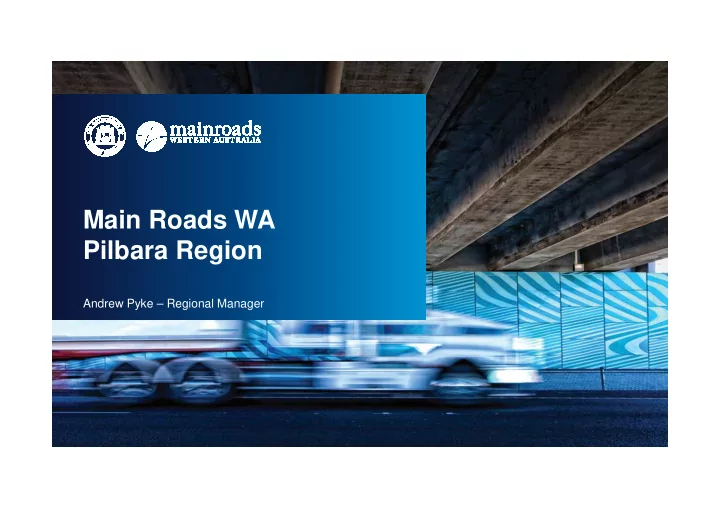

Main Roads WA Pilbara Region Andrew Pyke – Regional Manager
Some noteworthy statistics…
Why HVS is so important to us in the Pilbara…
Why HV freight is so important… � The Pilbara is a pastoralist region, which farms cattle for local and export markets. However, the Pilbara region is particularly rich in minerals, which is a major reason we need our HVS Network to operate safely, efficiently and effectively. Mining is a major contributor to our State’s wealth. � The main export, by mass, is iron ore (94.1%) but other commodities are also produced and include copper concentrate, spodumene (lithium), manganese, gas, salt and (previously) tantalum. � Whilst the majority of the Iron Ore is transported by rail, there is a ongoing desire to utilise road transport to facilitate mining operations. This has lead to substantial increases of RAV 10 vehicles (53.5m and 60m road trains) on parts of the Main Roads Network.
Where does it all go? � The Pilbara Port Authority oversees two of the worlds largest bulk export ports with 50% of the worlds seaborne Iron Ore movements commencing their journey’s from the Pilbara. � There are 5 major ports in the Pilbara and more are planned… � Port Hedland (with future extensions planned) � Cape Lambert � Dampier � Onslow � Cape Preston (with future extensions planned) � Anketell (future) � Balla Balla (future)
Continued… � Some of these ports only have a minimum HVS impact (say logistics support), while others have very heavy HVS utilisation. � The Utah Point facility in Port Hedland is currently operating at or above its design capacity of 20Mtpa, which means it accommodates between 600 and 750 RAV 10 vehicle deliveries per day. � In addition to the Iron Ore transport on roads leading to Utah Point, there are other important heavy freights tasks also in transit, including livestock, gas, salt, general freight, etc. Subsequently, on any given day, we can expect between 1500 and 2000 RAV 10 vehicles on the northern parts of Great Northern Highway, which occupies a fair proportion of the road real-estate.
What we are targeting to assist HVS operation… � Mining and PBS vehicles operate at 90km/h, which creates speed differentials with the remainder of the traffic in open areas posted at 110km/h. As such, safe overtaking opportunities is a key area we need to improve. � Fatigue management is a key safety issue for all drivers but more so for long haul HVS operators. We are looking to improve rest areas and where possible create dedicated HV Rest Areas to ‘free up space’ for RAV vehicles. � Animal strikes are a key concern for all road users and we have been working with pastoralists to increase awareness of the problem and to encourage the installation of more fences to reduce animal strike numbers. � Road and Rail conflicts are a key risk area for HVS in view of their operational capacity – it takes longer to stop and longer to get up to speed, so replacing at- grade crossings is a key HVS strategy for MRWA.
Current Projects (completion in 2018/19) � Coongan Gorge – new alignment to improve geometry and HVS access � Limestone Rd/Marble Bar Rd intersection – improve HVS intersection movement � Roy Hill Iron Ore Bridge – removes at-grade crossing � Onslow Upgrade Phase 1 – structural improvement to cater for future HVS � Karratha Tom Price Road Stage 3B – provides access for mining support � Bridge Approach Slab Refurbishment – improves bridge longevity for HVS usage (and a better ride for trucks on the bridge) � Overtake lanes 2x GNH 1x NWCH – improves HVS interaction with other traffic � Paraburdoo-Tom Price - various safety improvements including widening
Projects under Development Port Hedland Road Duplication – improves road efficiency, reduces conflict, has new second carriageway bridge and provides alternative emergency access (developed but unfunded). Great Northern Highway Realignment (Stage 2) – creates a separation of HVS from turning commuter traffic and removes at- grade rail crossing (partly funded and developed) FMG’s Solomon Bridge on GNH – removes the at-grade rail crossing (will be funded and delivered in 2019)
Continued… Onslow Road upgrade Phase 2 - structural improvement and intersection upgrades to cater for future HVS (developed and funded, to be delivered in 2019) BBI/Flinders Bridge on NWCH (Whim Creek) – eliminates any at-grade crossing (not developed or funded at this stage) Fencing Agreements on NWCH, GNH and Marble Bar Rd – eliminates animal strikes (agreements pending, partly funded) Road Train Assembly Areas (Karratha, Hedland, Roebourne) - unfunded
Continued… Rio Tinto’s Koodaideri Bridge on GNH – eliminates any at-grade crossing from the start of the mine opening (will be funded and delivered in 2019) BHP’s Buttweld Road Bridge - removes the at-grade rail crossing, provides a suitable second access to Sth Hedland and potentially improves HVS opportunities (some BHP funding issues with this at present) Marble Bar Road various improvements between Nullagine and Newman – improves road use efficiency, road safety (replacing the unsealed road) and road serviceability (some developed sections, none funded)
Animal strike stats…
Questions?
Recommend
More recommend